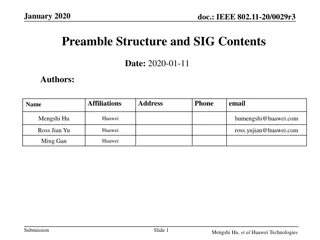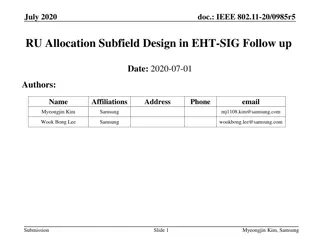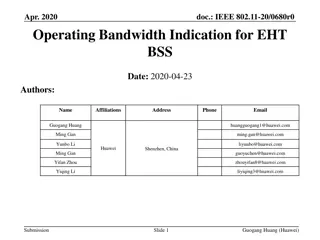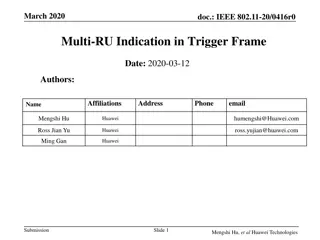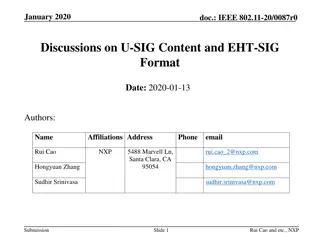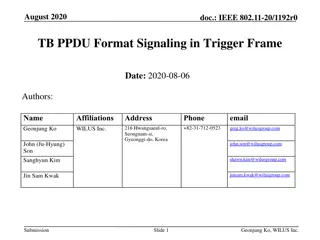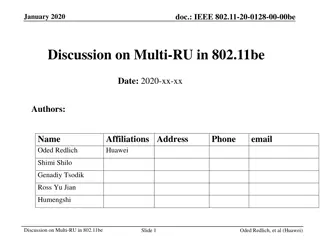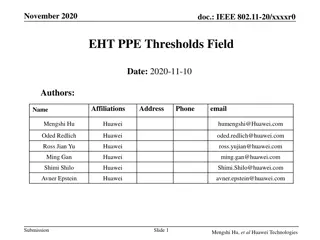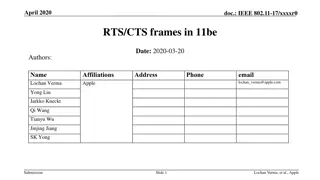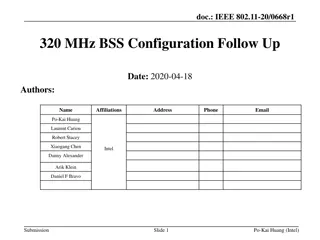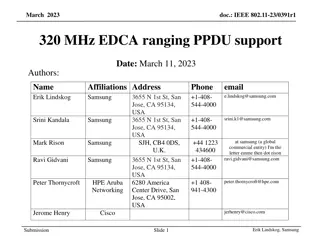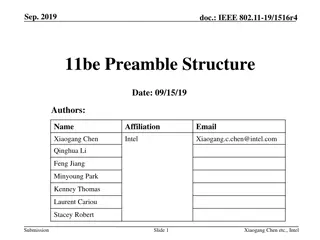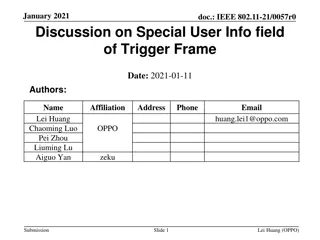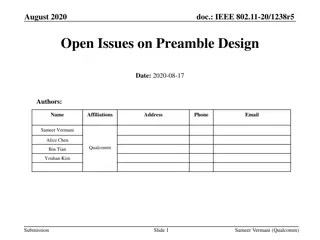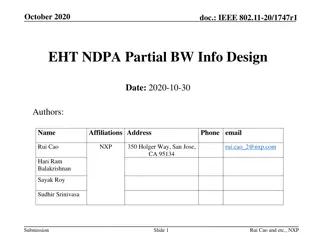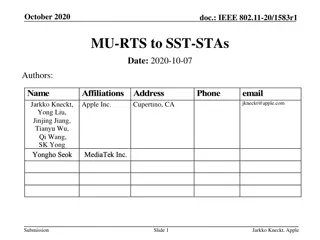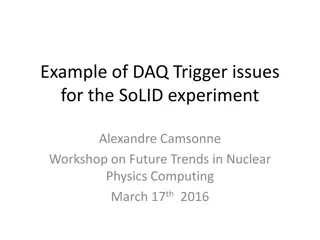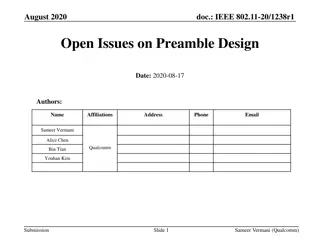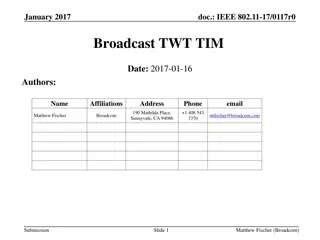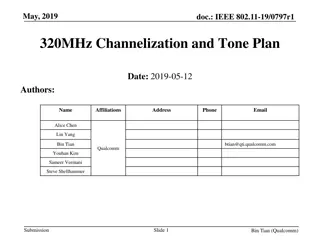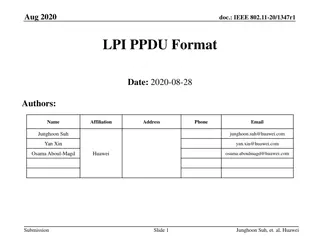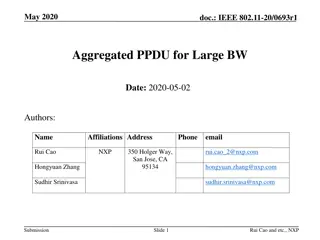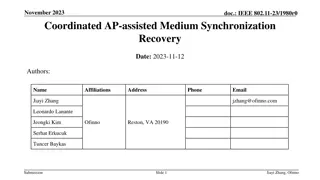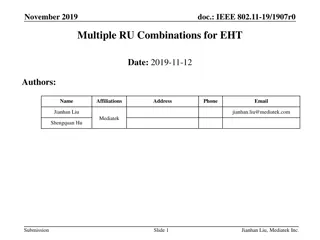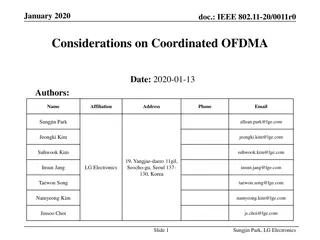Designing 9-Bit RU Allocation Subfield for EHT Trigger Frame in IEEE 802.11-20
IEEE 802.11-20/1845r2 presents a proposal for enhancing the RU allocation subfield design in the EHT Trigger frame to accommodate bandwidth support up to 320MHz and multiple RU or MRU allocations for UL MU transmissions in the 11be standard. The modification addresses inconsistencies in MRU mapping rules and enables efficient resource allocation for HE TB PPDU transmissions. The extended 9-bit RU allocation subfield allows precise indication of BW and RU/MRU assignments for improved performance.
Download Presentation

Please find below an Image/Link to download the presentation.
The content on the website is provided AS IS for your information and personal use only. It may not be sold, licensed, or shared on other websites without obtaining consent from the author. Download presentation by click this link. If you encounter any issues during the download, it is possible that the publisher has removed the file from their server.
E N D
Presentation Transcript
Nov 2020 doc.: IEEE 802.11-20/1845r2 RU Allocation Subfield Design for EHT Trigger Frame Follow up Date: 2020-11-11 Authors: Name Affiliations Address Phone email Myeongjin Kim Samsung mj1108.kim@samsung.com Wook Bong Lee Samsung wookbong.lee@samsung.com Submission Slide 1 Myeongjin Kim, Samsung
Nov 2020 doc.: IEEE 802.11-20/1845r2 Introduction 11be task group has approved that 11be shall allow the following PHY features [1]. 320 MHz PPDU 802.11be shall allow more than one RUs to be assigned to a single STA. Design aspects regarding Trigger frame to support these above features have been discussed in several contributions [2][3]. In [4], we proposed the 9-bit RU Allocation subfield for EHT Trigger frame so that RU allocation signaling for Trigger based UL MU transmissions can cover the supported bandwidths and MRU combinations. Submission Slide 2 Myeongjin Kim, Samsung
Nov 2020 doc.: IEEE 802.11-20/1845r2 Introduction (Cont d) In [5], 9-bit RU Allocation subfield considering 11ax backward compatibility for EHT Trigger frame was proposed. For all cases excepting 2 RU996+RU484, MRU index can be indicated by MSB, second MSB, and remaining 7 bits. In case of 2 RU996+RU484, MSB and second MSB provide the location of punctured RU484 while the remaining 7 bits indicate whether lower 240MHz or upper 240MHz. So, the mapping rule for MRU of 2 RU996+RU484 is not consistent with the mapping rules for the others. Therefore, in this contribution, we address modified 9-bit RU Allocation subfield for Trigger frame by changing the mapping rule only for MRU of 2 RU996+RU484 from RU Allocation subfield table in [5]. Submission Slide 3 Myeongjin Kim, Samsung
Nov 2020 doc.: IEEE 802.11-20/1845r2 EHT Trigger Frame Format In 11ax, a Trigger frame allocates resources for and solicits one or more HE TB PPDU transmissions. The Trigger frame also carries other information required by the responding STA to send an HE TB PPDU. Trigger frame format in 11ax Frame Control Common Info User Info List Duration RA TA Padding FCS EHT Trigger frame can be designed by modifying an existing HE Trigger frame in order to allocate RU or MRU to STAs for UL MU transmissions in EHT. E.g., UL BW in Common Info is expanded to support BW of 320MHz. (2 bits => 3 bits) E.g., RU Allocation subfield in User Info field is expanded to indicate MRU assignment. We focus on RU Allocation subfield design to enable trigger based UL MU in 11be to support BW of 320MHz and MRU aggregation. Submission Slide 4 Myeongjin Kim, Samsung
Nov 2020 doc.: IEEE 802.11-20/1845r2 Structure of RU Allocation subfield for Each STA Existing 8-bit RU Allocation subfield in User info field in Trigger frame does not allow indicating BW of 320MHz and multiple RU or MRU allocation information. To support the larger bandwidths and MRU combinations, we can consider the extended 9-bit RU allocation subfield. RU Allocation subfield for EHT X8 X7 X6 X5 X4 X3 X2 X1 X0 2 bits of [X1 X0]: Used to indicate the location of channel that RU allocation applies 7 bits of [X8 - X2]: Used to indicate RU or MRU assignment Submission Slide 5 Myeongjin Kim, Samsung
Nov 2020 doc.: IEEE 802.11-20/1845r2 RU Allocation Subfield for 320 MHz BW In 11ax, one bit (B0) in the RU Allocation subfield in Trigger frame is used to indicate the Primary 80MHz or Secondary 80MHz channel. To cover the supported bandwidth of 320 MHz in EHT, it is preferred to use two bits, [X1 X0], to indicate the location of channel that RU or MRU allocation applies as follows. X0 (LU) If the UL BW subfield indicates 320 MHz, X0 of the RU Allocation subfield is set to 0 to indicate that the RU allocation applies to the lower 160 MHz channel and set to 1 to indicate that the RU allocation applies to the upper 160 MHz channel. (Lower/Upper 160 MHz channel) If the UL BW subfield indicates 320 MHz, X1 of the RU Allocation subfield is set to 0 to indicate that the RU allocation applies to the lower 80 MHz channel in 160 MHz as indicated by X0 of the RU Allocation subfield and set to 1 to indicate that the RU allocation applies to the upper 80 MHz channel in 160 MHz as indicated by X0 of the RU Allocation subfield. If the UL BW subfield indicates 160 MHz, X1 of the RU Allocation subfield is set to 0 to indicate that the RU allocation applies to the lower 80 MHz channel and set to 1 to indicate that the RU allocation applies to the upper 80 MHz channel. X1 Example [X1 X0] Lower 160MHz Upper 160MHz Lower 80MHz Upper 80MHz Lower 80MHz Upper 80MHz 160MHz [0 x] [1 x] - - 320 MHz [0 0] [1 0] [0 1] [1 1] Submission Slide 6 Myeongjin Kim, Samsung
Nov 2020 doc.: IEEE 802.11-20/1845r2 26-tone RU Indices in Both DL and UL for 11be In 802.11be D0.1, indices of RU1 to RU36 for 26-tone RUs are defined in an 80MHz EHT PPDU. This is not consistent with 11ax. In [5], they proposed to define the 26-tone RU indices in UL for an 80MHz EHT PPDU as follows for the consistency with 11ax, RU36 11be D0.1 RU1 RU18 RU19 Proposed 26-tone RU Indices for 11be RU37 RU1 RU18 RU19 RU20 RU1-RU18 for lower 40MHz and RU20-RU37 in upper 40MHz There is the index of RU19 for 26-tone DC RU (RU19 is the DC RU in HE OFDMA 80MHz). But it does not exist in 11be. For the consistency in DL and UL, we propose to apply this modified 26-tone RU indices in both DL and UL. Submission Slide 7 Myeongjin Kim, Samsung
Nov 2020 doc.: IEEE 802.11-20/1845r2 26-tone RU Indices in Both DL and UL for 11be (Cont d) We propose to use the following modified 26-tone RU indices for an 80MHz, 160MHz, and 320HMz EHT PPDU in both DL and UL. 26-tone RU indices for an 80MHz EHT PPDU in both DL and UL RU type RU index and subcarrier range RU 1 RU 2 RU 3 RU 4 RU 5 [ 499: 474] [ 473: 448] [ 445: 420] [ 419: 394] [ 392: 367] RU 6 RU 7 RU 8 RU 9 [ 365: 340] [ 339: 314] [ 311: 286] [ 285: 260] RU 10 [ 252: 227] RU 11 [ 226: 201] RU 12 [ 198: 173] RU 13 [ 172: 147] RU 14 [ 145: 120] RU 19 RU 15 [ 118: 93] RU 16 [ 92: 67] RU 17 [ 64: 39] RU 18 [ 38: 13] [It does not exist.] 26-tone RU RU 20 [13: 38] RU 21 [39: 64] RU 22 [67: 92] RU 23 [93: 118] RU 24 [120: 145] RU 25 [147: 172] RU 26 [173: 198] RU 27 [201: 226] RU 28 [227: 252] RU 29 [260: 285] RU 30 [286: 311] RU 31 [314: 339] RU 32 [340: 365] RU 33 [367: 392] RU 34 [394: 419] RU 35 [420: 445] RU 36 [448: 473] RU 37 [474: 499] RU1-RU18 for lower 40MHz and RU20-RU37 in upper 40MHz There is the index of RU19 for 26-tone DC RU. But it does not exist in 11be. 26-tone RU indices in both DL and UL for a 160MHz and 320HMz EHT PPDU are defined based on 26-tone RU indices for an 80MHz EHT PPDU above in both DL and UL. (Please, refer to the Word document for the detailed 26-tone RU indices in both DL and UL for a 160MHz and 320HMz EHT PPDU) Submission Slide 8 Myeongjin Kim, Samsung
Nov 2020 doc.: IEEE 802.11-20/1845r2 Indication for Multiple RU Allocation Info Considering the number of entries needed for MRU combinations, it is possible to indicate the allocated MRU aggregation to STAs with the reserved entries of RU Allocation subfield table for the Trigger frame in 11ax . First, we define indices for MRU combinations based on data and pilot subcarrier indices for RUs. Then, based on the defined indices for MRU combinations, new entries to indicate various combinations for MRU aggregation are added to the conventional RU Allocation subfield in 11ax. In the followings, the details of RU Allocation subfield design for indication of allocated MRU are described. Submission Slide 9 Myeongjin Kim, Samsung
Nov 2020 doc.: IEEE 802.11-20/1845r2 Define Indices for MRUs Based on Table 27-7 & Table 27-8 in 11ax, the location of MRUs are defined as follows. Indices for small-size MRUs in an OFDMA 20 MHz EHT PPDU and MRU type MRU index MRU 1 MRU 2 MRU 3 MRU 1 MRU 2 MRU combination 52-tone RU 2 + 26-tone RU 2 52-tone RU 2 + 26-tone RU 5 52-tone RU 3 + 26-tone RU 8 106-tone RU 1 + 26-tone RU 5 106-tone RU 2 + 26-tone RU 5 RU52+RU26 RU106+RU26 Indices for MRUs are defined based on RU indices in Table 27-7 (Data and pilot subcarrier indices for RUs in a 20 MHz HE PPDU and in a non-OFDMA 20 MHz HE PPDU). Indices for small-size MRUs in an OFDMA 40 MHz EHT PPDU MRU type MRU index MRU 1 MRU 2 MRU 3 MRU 4 MRU 5 MRU 6 MRU 1 MRU 2 MRU 3 MRU 4 MRU combination 52-tone RU 2 + 26-tone RU 2 52-tone RU 2 + 26-tone RU 5 52-tone RU 3 + 26-tone RU 8 52-tone RU 6 + 26-tone RU 11 52-tone RU 6 + 26-tone RU 14 52-tone RU 7 + 26-tone RU 17 106-tone RU 1 + 26-tone RU 5 106-tone RU 2 + 26-tone RU 5 106-tone RU 3 + 26-tone RU 14 106-tone RU 4 + 26-tone RU 14 RU52+RU26 RU106+RU26 Indices for MRUs are defined based on RU indices in Table 27-8 (Data and pilot subcarrier indices for RUs in a 40 MHz HE PPDU and in a non-OFDMA 40 MHz HE PPDU). Slide 10 Submission Myeongjin Kim, Samsung
Nov 2020 doc.: IEEE 802.11-20/1845r2 Define Indices for MRUs (Cont d) The location of MRUs are defined as follows. Indices for small-size MRUs in an OFDMA 80 MHz EHT PPDU MRU type MRU index MRU 1 MRU 2 MRU combination 52-tone RU 2 + 26-tone RU 2 52-tone RU 2 + 26-tone RU 5 Note Not supported in BW 80 MHz - MRU 3 52-tone RU 3 + 26-tone RU 8 - MRU 4 52-tone RU 6 + 26-tone RU 11 - MRU 5 52-tone RU 6 + 26-tone RU 14 - Not supported in BW 80 MHz MRU 6 52-tone RU 7 + 26-tone RU 17 RU52+RU26 MRU 7 52-tone RU 10 + 26-tone RU 21 Not supported in BW 80 MHz MRU 8 52-tone RU 10 + 26-tone RU 24 - MRU 9 52-tone RU 11 + 26-tone RU 27 - MRU 10 52-tone RU 14 + 26-tone RU 30 - MRU 11 52-tone RU 14 + 26-tone RU 33 - MRU 12 52-tone RU 15 + 26-tone RU 36 Not supported in BW 80 MHz MRU 1 MRU 2 MRU 3 MRU 4 106-tone RU 1 + 26-tone RU 5 106-tone RU 2 + 26-tone RU 5 106-tone RU 3 + 26-tone RU 14 106-tone RU 4 + 26-tone RU 14 - Not supported in BW 80 MHz Not supported in BW 80 MHz - RU106+RU26 MRU 5 106-tone RU 5 + 26-tone RU 24 - MRU 6 106-tone RU 6 + 26-tone RU 24 Not supported in BW 80 MHz MRU 7 106-tone RU 7 + 26-tone RU 33 Not supported in BW 80 MHz MRU 8 106-tone RU 8 + 26-tone RU 33 - Indices for MRUs are defined based on 52-tone RU indices in Table 36.5 (Data and pilot subcarrier indices for RUs in an 80 MHz EHT PPDU (11be D0.1)) and 26-tone RU indices in slide 8 (Proposed 26- tone RU Indices in Both DL and UL for 11be). Slide 11 Submission Myeongjin Kim, Samsung
Nov 2020 doc.: IEEE 802.11-20/1845r2 Define Indices for MRUs (Cont d) The location of MRUs are defined as follows. Indices for large-size MRUs in an 80 MHz EHT PPDU and in a non-OFDMA 80 MHz EHT PPDU MRU type MRU index MRU combination MRU 1 RU484+RU242; [empty-RU242 RU242 RU484] MRU 2 RU484+RU242; [RU242 empty-RU242 RU484] RU484+RU242 MRU 3 RU484+RU242; [RU484 empty-RU242 RU242] MRU 4 RU484+RU242; [RU484 RU242 empty-RU242] Submission Slide 12 Myeongjin Kim, Samsung
Nov 2020 doc.: IEEE 802.11-20/1845r2 Define Indices for MRUs (Cont d) The location of MRUs are defined as follows. Indices for large-size MRUs in an 160MHz EHT PPDU and in a non-OFDMA 160MHz EHT PPDU MRU type MRU index MRU combination MRU 1 RU996+RU484; [empty-RU484 RU484 RU996] MRU 2 RU996+RU484; [RU484 empty-RU484 RU996] RU996+RU484 MRU 3 RU996+RU484; [RU996 empty-RU484 RU484] MRU 4 RU996+RU484; [RU996 RU484 empty-RU484] MRU 1 RU996+RU484+RU242; [empty-RU242 RU242 RU484 RU996] MRU 2 RU996+RU484+RU242; [RU242 empty-RU242 RU484 RU996] MRU 3 RU996+RU484+RU242; [RU484 empty-RU242 RU242 RU996] RU996+RU484+ RU242 (Only for non-OFDMA) MRU 4 RU996+RU484+RU242; [RU484 RU242 empty-RU242 RU996] MRU 5 RU996+RU484+RU242; [RU996 empty-RU242 RU242 RU484] MRU 6 RU996+RU484+RU242; [RU996 RU242 empty-RU242 RU484] MRU 7 RU996+RU484+RU242; [RU996 RU484 empty-RU242 RU242] MRU 8 RU996+RU484+RU242; [RU996 RU484 RU242 empty-RU242] Submission Slide 13 Myeongjin Kim, Samsung
Nov 2020 doc.: IEEE 802.11-20/1845r2 Define Indices for MRUs (Cont d) The location of MRUs are defined as follows. Indices for large-size MRUs in a 320MHz EHT PPDU and in a non-OFDMA 320MHz EHT PPDU MRU type MRU index MRU 1 MRU combination 2 RU996+RU484; [empty-RU484 RU484 RU996 RU996 empty-RU996] MRU 2 2 RU996+RU484; [RU484 empty-RU484 RU996 RU996 empty-RU996] MRU 3 2 RU996+RU484; [RU996 empty-RU484 RU484 RU996 empty-RU996] MRU 4 2 RU996+RU484; [RU996 RU484 empty-RU484 RU996 empty-RU996] MRU 5 2 RU996+RU484; [RU996 RU996 empty-RU484 RU484 empty-RU996] MRU 6 2 RU996+RU484; [RU996 RU996 RU484 empty-RU484 empty-RU996] 2 RU996+RU484 MRU 7 2 RU996+RU484; [empty-RU996 empty-RU484 RU484 RU996 RU996] MRU 8 2 RU996+RU484; [empty-RU996 RU484 empty-RU484 RU996 RU996] MRU 9 2 RU996+RU484; [empty-RU996 RU996 empty-RU484 RU484 RU996] MRU 10 2 RU996+RU484; [empty-RU996 RU996 RU484 empty-RU484 RU996] MRU 11 2 RU996+RU484; [empty-RU996 RU996 RU996 empty-RU484 RU484] MRU 12 MRU 1 MRU 2 MRU 3 MRU 4 MRU 1 2 RU996+RU484; [empty-RU996 RU996 RU996 RU484 empty-RU484] 3 RU996; [empty-RU996 RU996 RU996 RU996] 3 RU996; [RU996 empty-RU996 RU996 RU996] 3 RU996; [RU996 RU996 empty-RU996 RU996] 3 RU996; [RU996 RU996 RU996 empty-RU996] 3 RU996+RU484; [empty-RU484 RU484 RU996 RU996 RU996] 3 RU996 MRU 2 3 RU996+RU484; [RU484 empty-RU484 RU996 RU996 RU996] MRU 3 3 RU996+RU484; [RU996 empty-RU484 RU484 RU996 RU996] MRU 4 3 RU996+RU484; [RU996 RU484 empty-RU484 RU996 RU996] 3 RU996+RU484 MRU 5 3 RU996+RU484; [RU996 RU996 empty-RU484 RU484 RU996] MRU 6 3 RU996+RU484; [RU996 RU996 RU484 empty-RU484 RU996] MRU 7 3 RU996+RU484; [RU996 RU996 RU996 empty-RU484 RU484] MRU 8 3 RU996+RU484; [RU996 RU996 RU996 RU484 empty-RU484] Submission Slide 14 Myeongjin Kim, Samsung
Nov 2020 doc.: IEEE 802.11-20/1845r2 RU Allocation Subfield Design for RU, Small-size MRU, and RU484+RU242 Two bits of [X1 X0] are used to indicate the location of channel that RU or small-size MRU or MRU combinations of RU484+RU242 apply. [X8-X2] is used to indicate the defined indices for RU or small-size MRU or MRU combinations of RU484+RU242 as follows. UL BW subfield X0(LU) X1 RU Allocation subfield 0-8 20 MHz, 40 MHz, 80 MHz, 160 MHz, 320 MHz 9 17 40 MHz, 80 MHz, 160 MHz, 320 MHz 18 -- 19 36 80 MHz, 160 MHz, 320 MHz 37 30 20 MHz, 40 MHz, 80 MHz, 160 MHz, 320 MHz 41 44 40 MHz, 80 MHz, 160 MHz, 320 MHz 45 52 80 MHz, 160 MHz, 320 MHz 53, 54 20 MHz, 40 MHz, 80 MHz, 160 MHz, 320 MHz 55, 56 40 MHz, 80 MHz, 160 MHz, 320 MHz 57 60 80 MHz, 160 MHz, 320 MHz 61 20 MHz, 40 MHz, 80 MHz, 160 MHz, 320 MHz 72 40 MHz, 80 MHz, 160 MHz, 320 MHz 63,64 80 MHz, 160 MHz, 320 MHz 65 40 MHz, 80 MHz, 160 MHz, 320 MHz 66 80 MHz, 160 MHz, 320 MHz 67 80 MHz, 160 MHz, 320 MHz 68 160 MHz, 320 MHz 69 320 MHz 70-72 20 MHz, 40 MHz, 80 MHz, 160 MHz, 320 MHz 73-75 40 MHz, 80 MHz, 160 MHz, 320 MHz 76-81 80 MHz, 160 MHz, 320 MHz 82,83 20 MHz, 40 MHz, 80 MHz, 160 MHz, 320 MHz 84,85 40 MHz, 80 MHz, 160 MHz, 320 MHz 86-89 80 MHz, 160 MHz, 320 MHz 90-93 80 MHz, 160 MHz, 320 MHz 9 bits RU Allocation subfield X8-X2 of RU size RU Index RU1 to RU9, respectively RU10 to RU18, respectively RU19 (It does not exist in 11be.) RU20 to RU37, respectively RU1 to RU4, respectively RU5 to RU8, respectively RU9 to RU16, respectively RU1 and RU2, respectively RU3 and RU4, respectively RU5 to RU8, respectively RU1 RU2 RU3 and RU4, respectively RU1 RU2 RU1 RU1 RU1 MRU1 to MRU3, respectively MRU4 to MRU6, respectively MRU7 to MRU12, respectively MRU1 and MRU2, respectively MRU3 and MRU4, respectively MRU5 to MRU8, respectively MRU1 to MRU4, respectively RU26 RU52 RU106 [X0 X1] are used to indicate the location of channel that RU or MRU allocation applies. RU242 RU484 RU996 2 996 4 RU996 RU52+RU26 RU106+RU26 RU484+RU242 Submission Slide 15 Myeongjin Kim, Samsung
Nov 2020 doc.: IEEE 802.11-20/1845r2 RU Allocation Subfield Design for RU996+RU484 MRU combinations of RU996+RU484 are allowed within 160MHz channels. So, X1 is not used to indicate the channel. [X8-X1] is used to indicate the defined indices for MRU combinations of RU996+RU484 by informing the punctured RU484 as follows. Location of punctured RU484 with (X1 2) + (X8- X2) 94 0 9bits RU Allocation subfield RU size RU Index X8-X2 of X0(LU) X1 RU Allocation subfield 94 0 MRU1 [X0] is used to indicate the location of channel that RU or MRU allocation applies. 0 95 1 MRU2 RU996+RU484 1 94 2 MRU3 1 95 3 MRU4 Submission Slide 16 Myeongjin Kim, Samsung
Nov 2020 doc.: IEEE 802.11-20/1845r2 RU Allocation Subfield Design for RU996+RU484+RU242 MRU combinations of RU996+RU484+RU242 are allowed within 160MHz channels. So, X1 is not used to indicate the channel. [X8-X1] is used to indicate the defined indices for MRU combinations of RU996+RU484+RU242 by informing the punctured RU242 as follows. Location of punctured RU242 with (X1 22) + (X8- X2) - 96 0 1 2 3 4 5 6 7 9bits RU Allocation subfield RU size RU Index X8-X2 of X0(LU) X1 RU Allocation subfield 0 0 0 0 1 1 1 1 96 97 98 99 96 97 98 99 MRU1 MRU2 MRU3 MRU4 MRU5 MRU6 MRU7 MRU8 [X0] is used to indicate the location of channel that RU or MRU allocation applies. RU996+RU484+ RU242 Submission Slide 17 Myeongjin Kim, Samsung
Nov 2020 doc.: IEEE 802.11-20/1845r2 RU Allocation Subfield Design for 2 RU996+RU484 MRU combinations of 2 RU996+RU484 are allowed within 320MHz channels. So, 2bits of [X1 X0] are not used to indicate the channel. [X8-X0] is used to indicate the defined indices for MRU combinations of 2 RU996+RU484 by informing the punctured RU996 and RU484 as follows. X0 is used to indicate of the location of punctured RU996. [X8-X1] are used to indicate of the punctured RU484 in the certain 3 RU996. Location of punctured RU484 with (X1 22) + (X8-X2) 100 0 1 2 3 4 5 0 1 2 3 4 5 9bits RU Allocation subfield RU size RU Index X8-X2 of X0(LU) X1 RU Allocation subfield 100 101 102 103 100 101 100 101 102 103 100 101 0 0 0 0 0 0 1 1 1 1 1 1 0 0 0 0 1 1 0 0 0 0 1 1 MRU1 MRU2 MRU3 MRU4 MRU5 MRU6 MRU7 MRU8 MRU9 MRU10 MRU11 MRU12 2 RU996+RU484 Submission Slide 18 Myeongjin Kim, Samsung
Nov 2020 doc.: IEEE 802.11-20/1845r2 RU Allocation Subfield Design for 2 RU996+RU484 (Cont d) Submission Slide 19 Myeongjin Kim, Samsung
Nov 2020 doc.: IEEE 802.11-20/1845r2 RU Allocation Subfield Design for 3 RU996 MRU combinations of 3 RU996 are allowed within 320MHz channels. So, 2bits of [X1 X0] are not used to indicate the channel. [X8-X0] is used to indicate the defined indices for MRU combinations of 3 RU996 by informing the punctured RU996 as follows. Location of punctured RU996 with (X0 2) + (X1) 0 1 2 3 9bits RU Allocation subfield RU size RU Index X8-X2 of X0(LU) X1 RU Allocation subfield 104 104 104 104 0 0 1 1 0 1 0 1 MRU1 MRU2 MRU3 MRU4 3 RU996 Submission Slide 20 Myeongjin Kim, Samsung
Nov 2020 doc.: IEEE 802.11-20/1845r2 RU Allocation Subfield Design for 3 RU996+RU484 MRU combinations of 3 RU996+RU484 are allowed within 320MHz channels. So, 2bits of [X1 X0] are not used to indicate the channel. [X8-X0] is used to indicate the defined indices for MRU combinations of 3 RU996+RU484 by informing the punctured RU484 as follows. Location of punctured RU484 with (X0 22) + (X1 21) + (X8- X2) 105 0 1 2 3 4 5 6 7 9bits RU Allocation subfield RU size RU Index X8-X2 of X0(LU) X1 RU Allocation subfield 0 0 0 0 1 1 1 1 0 0 1 1 0 0 1 1 105 106 105 106 105 106 105 106 MRU1 MRU2 MRU3 MRU4 MRU5 MRU6 MRU7 MRU8 3 RU996+RU484 Submission Slide 21 Myeongjin Kim, Samsung
Nov 2020 doc.: IEEE 802.11-20/1845r2 RU Allocation Subfield Design for 3 RU996+RU484 (Cont d) Submission Slide 22 Myeongjin Kim, Samsung
Nov 2020 doc.: IEEE 802.11-20/1845r2 RU Allocation Subfield Table for EHT Trigger frame Based on the previous logics, the mapping of X8 X0 of the RU Allocation subfield for EHT Trigger frame is defined as follows. 9 bits RU Allocation subfield X8-X2 of RU Allocation subfield 0-8 9 17 18 19 36 37 30 41 44 45 52 53, 54 55, 56 57 60 61 72 63,64 65 66 67 68 69 70-72 73-75 76-81 82,83 84,85 86-89 90-93 UL BW subfield RU size RU Index X0(LU) X1 20 MHz, 40 MHz, 80 MHz, 160 MHz, 320 MHz 40 MHz, 80 MHz, 160 MHz, 320 MHz -- 80 MHz, 160 MHz, 320 MHz 20 MHz, 40 MHz, 80 MHz, 160 MHz, 320 MHz 40 MHz, 80 MHz, 160 MHz, 320 MHz 80 MHz, 160 MHz, 320 MHz 20 MHz, 40 MHz, 80 MHz, 160 MHz, 320 MHz 40 MHz, 80 MHz, 160 MHz, 320 MHz 80 MHz, 160 MHz, 320 MHz 20 MHz, 40 MHz, 80 MHz, 160 MHz, 320 MHz 40 MHz, 80 MHz, 160 MHz, 320 MHz 80 MHz, 160 MHz, 320 MHz 40 MHz, 80 MHz, 160 MHz, 320 MHz 80 MHz, 160 MHz, 320 MHz 80 MHz, 160 MHz, 320 MHz 160 MHz, 320 MHz 320 MHz 20 MHz, 40 MHz, 80 MHz, 160 MHz, 320 MHz 40 MHz, 80 MHz, 160 MHz, 320 MHz 80 MHz, 160 MHz, 320 MHz 20 MHz, 40 MHz, 80 MHz, 160 MHz, 320 MHz 40 MHz, 80 MHz, 160 MHz, 320 MHz 80 MHz, 160 MHz, 320 MHz 80 MHz, 160 MHz, 320 MHz RU1 to RU9, respectively RU10 to RU18, respectively RU19 (It does not exist in 11be.) RU20 to RU37, respectively RU1 to RU4, respectively RU5 to RU8, respectively RU9 to RU16, respectively RU1 and RU2, respectively RU3 and RU4, respectively RU5 to RU8, respectively RU1 RU2 RU3 and RU4, respectively RU1 RU2 RU1 RU1 RU1 MRU1 to MRU3, respectively MRU4 to MRU6, respectively MRU7 to MRU12, respectively MRU1 and MRU2, respectively MRU3 and MRU4, respectively MRU5 to MRU8, respectively MRU1 to MRU4, respectively RU26 RU52 RU106 [X0 X1] are used to indicate the location of channel that RU or MRU allocation applies. RU242 RU484 RU996 2 996 4 RU996 RU52+RU26 RU106+RU26 RU484+RU242 Submission Slide 23 Myeongjin Kim, Samsung
Nov 2020 doc.: IEEE 802.11-20/1845r2 RU Allocation Subfield Table for EHT Trigger frame (Cont d) 9 bits RU Allocation subfield UL BW subfield RU size RU Index X8-X2 of X0 X1 0 0 1 1 0 0 0 0 1 1 1 1 0 0 0 0 1 1 0 0 0 0 1 1 0 1 0 1 0 0 1 1 0 0 1 1 RU Allocation subfield 94 95 94 95 96 97 98 99 96 97 98 99 100 101 102 103 100 101 100 101 102 103 100 101 104 104 104 104 105 106 105 106 105 106 105 106 MRU1 MRU2 MRU3 MRU4 MRU1 MRU2 MRU3 MRU4 MRU5 MRU6 MRU7 MRU8 MRU1 MRU2 MRU3 MRU4 MRU5 MRU6 MRU7 MRU8 MRU9 MRU10 MRU11 MRU12 MRU1 MRU2 MRU3 MRU4 MRU1 MRU2 MRU3 MRU4 MRU5 MRU6 MRU7 MRU8 160 MHz, 320 MHz RU996+RU484 [X0] is used to indicate the location of channel that RU or MRU allocation applies. RU996+RU484+RU 242 160 MHz, 320 MHz 0 0 0 0 0 0 1 1 1 1 1 1 0 0 1 1 0 0 0 0 1 1 1 1 320 MHz 2 RU996+RU484 320 MHz 3 RU996 320 MHz 3 RU996+RU484 Submission Slide 24 Myeongjin Kim, Samsung
Nov 2020 doc.: IEEE 802.11-20/1845r2 Summary In this contribution, we proposed the modified 9-bit RU Allocation subfield for Trigger frame to indicate the supported bandwidths and MRU combinations in EHT by changing the mapping rule only for MRU of 2 RU996+RU484 from RU Allocation subfield table in [5]. Submission Slide 25 Myeongjin Kim, Samsung
Nov 2020 doc.: IEEE 802.11-20/1845r2 R2 Updated SP2 to support the indices for small-size MRUs in an OFDMA 80MHz, 160MHz, and 320HMz EHT PPDU. Submission Slide 26 Myeongjin Kim, Samsung
Nov 2020 doc.: IEEE 802.11-20/1845r2 Straw Poll #1 Do you support the following 26-tone RU indices for an 80MHz, 160MHz, and 320HMz EHT PPDU in both DL and UL ? 26-tone RU indices for an 80MHz EHT PPDU in both DL and UL RU type RU index and subcarrier range RU 1 RU 2 RU 3 RU 4 RU 5 [ 499: 474] [ 473: 448] [ 445: 420] [ 419: 394] [ 392: 367] RU 6 RU 7 RU 8 RU 9 [ 365: 340] [ 339: 314] [ 311: 286] [ 285: 260] RU 10 [ 252: 227] RU 11 [ 226: 201] RU 12 [ 198: 173] RU 13 [ 172: 147] RU 14 [ 145: 120] RU 19 RU 15 [ 118: 93] RU 16 [ 92: 67] RU 17 [ 64: 39] RU 18 [ 38: 13] [It does not exist.] 26-tone RU RU 20 [13: 38] RU 21 [39: 64] RU 22 [67: 92] RU 23 [93: 118] RU 24 [120: 145] RU 25 [147: 172] RU 26 [173: 198] RU 27 [201: 226] RU 28 [227: 252] RU 29 [260: 285] RU 30 [286: 311] RU 31 [314: 339] RU 32 [340: 365] RU 33 [367: 392] RU 34 [394: 419] RU 35 [420: 445] RU 36 [448: 473] RU 37 [474: 499] RU1-RU18 for lower 40MHz and RU20-RU37 in upper 40MHz There is the index of RU19 for 26-tone DC RU. But it does not exist in 11be. 26-tone RU indices in both DL and UL for a 160MHz and 320HMz EHT PPDU are defined based on 26-tone RU indices for an 80MHz EHT PPDU above in both DL and UL. (Please, refer to the Word document for the detailed 26-tone RU indices in both DL and UL for a 160MHz and 320HMz EHT PPDU) Submission Slide 27 Myeongjin Kim, Samsung
Nov 2020 doc.: IEEE 802.11-20/1845r2 Straw Poll #2 Do you support that the TGbe SFD shall include the following table? Indices for small-size MRUs in an OFDMA 80MHz, 160MHz, and 320HMz EHT PPDU described in Word document Submission Slide 28 Myeongjin Kim, Samsung
Nov 2020 doc.: IEEE 802.11-20/1845r2 Straw Poll #3 Do you support the EHT Trigger Frame RU Allocation subfield table design described in slide 19-20 of 20/1845r2? Submission Slide 29 Myeongjin Kim, Samsung
Nov 2020 doc.: IEEE 802.11-20/1845r2 APPENDIX Submission Slide 30 Myeongjin Kim, Samsung
Nov 2020 doc.: IEEE 802.11-20/1845r2 Table 27-7 in 11ax: Data and pilot Subcarrier Indices for RUs in an 20 MHz HE PPDU and in a Non-OFDMA 20 MHz HE PPDU Submission Slide 31 Myeongjin Kim, Samsung
Nov 2020 doc.: IEEE 802.11-20/1845r2 Table 27-8 in 11ax: Data and pilot Subcarrier Indices for RUs in an 40 MHz HE PPDU and in a Non-OFDMA 40 MHz HE PPDU Submission Slide 32 Myeongjin Kim, Samsung
Nov 2020 doc.: IEEE 802.11-20/1845r2 Table 36.5-Data and pilot subcarrier indices for RUs in an 80 MHz EHT PPDU (11be D0.1) Submission Slide 33 Myeongjin Kim, Samsung
Nov 2020 doc.: IEEE 802.11-20/1845r2 Reference [1] 802.11-20/0566r23, Specification Framework for TGbe. [2] 802.11-20/0416r0, Multi-RU Indication in Trigger Frame. [3] 802.11-20/0413r1, Discussion on EHT Trigger based UL MU [4] 802.11-20/0828r6, RU Allocation Subfield Design for EHT Trigger Frame [5] 802.11-20/1703r1, IEEE 802.11ax Backward Compatible Trigger Frame RU Allocation Table [6] 802.11-20/1429r1, Enhanced Trigger Frame for EHT Support Submission Slide 34 Myeongjin Kim, Samsung


